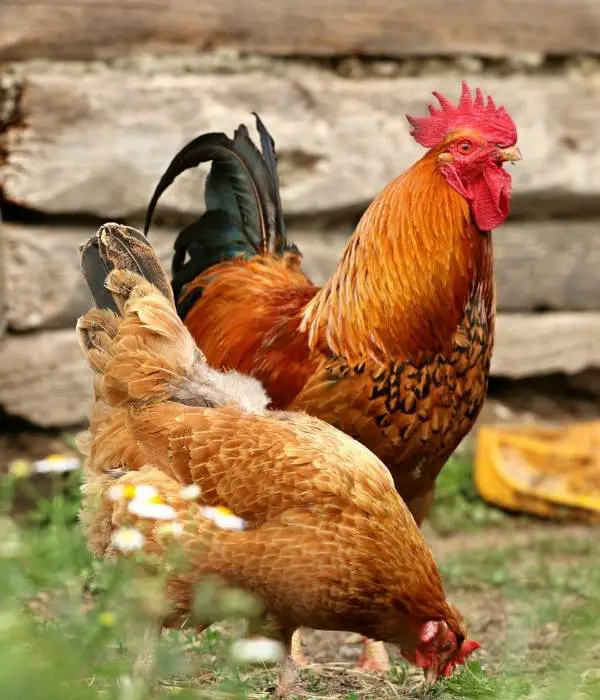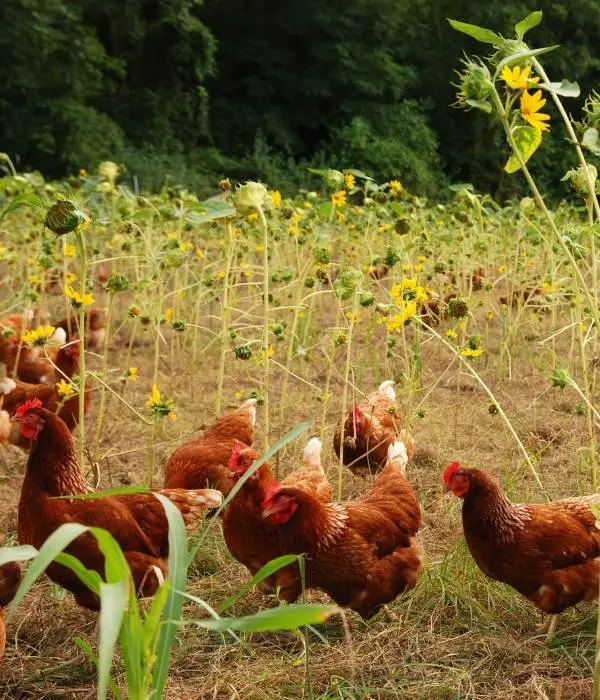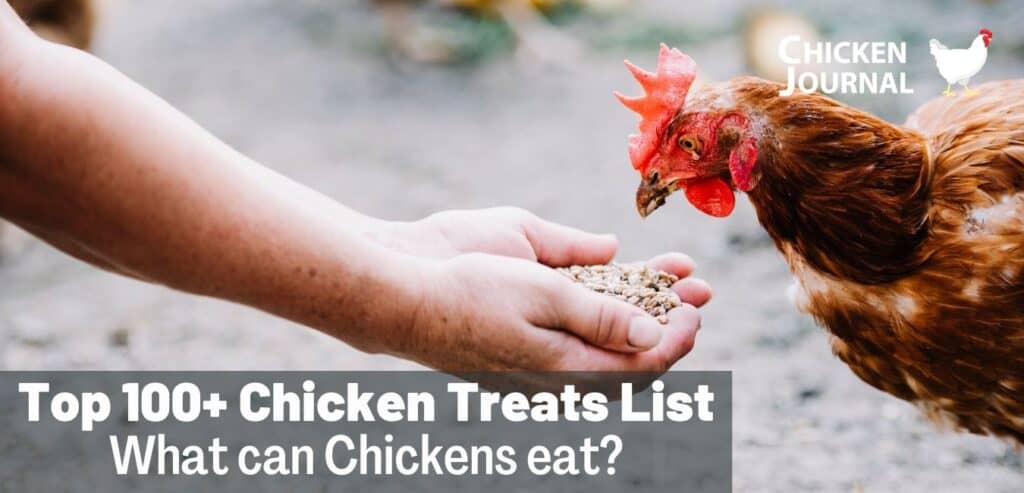Do you want to know all about free-range chickens? If yes! This guide is for you. In this guide you will read the meaning, pros, cons, and how it is different from broiler chicken, coop & feed management, with extra tips for caring.
What Are Free-Range Chickens?
This is a method of farming where chickens, like other animals, birds are allowed to move freely on the farm. Free-range chickens are those birds that are kept outdoors.
It can either be full-bodied or through pop holes where there is no full-bodied access to the outdoors. These types of chickens are reared in an open environment and live a less stressful life as compared to those that are confined in one area.
Fresh air and greenery are available to free-range and organic poultry. It is possible to improve the environment by adding trees, bushes for shade and protection.
Pecking, scratching and foraging, as well as fresh air and daylight, are some of the advantages of allowing chickens to live outside. Chickens raised in a free-range environment had greater leg and heart health, as well as a higher quality of life.
Also read: How to raise baby chicks? (Week 1 to 20)
Pros of Raising Free-Range Chickens

1. Broader Diet
Foraging for bugs, grass, and herbs is possible for free-range hens. They will eat a far broader variety of foods than if they were kept in a cage. This is great for the birds’ well-being and happiness.
2. Less Feed Costs
Foraging will provide some of the birds’ nutrition. Even if you free-range your chickens, you’ll save money on chicken feed. It’s always a good idea to save money and minimize costs!
3. Free-Ranging Chickens are Fun to Watch
Watching my chickens run around outside is one of my favorite pastimes. They’re a lot of fun to see. You’re missing out on a lot of enjoyable entertainment if you haven’t seen chickens fight over a worm or two roosters show each other who’s boss.
Also read: Mealworms for chicken’s
4. Richer Eggs
Compared to a store-bought or caged chicken egg, the yolks of free-ranging chicken eggs are noticeably different in hue.
They are rich in vitamins, minerals, and good fats, and the yolks of free-range eggs are a richer yellow (sometimes almost orange). Moreover, I think they taste better than before.
Also read: List of best egg laying free-range chickens
5. Healthier Meat
When hens are allowed to roam freely, they are more likely to eat a more natural and healthy diet. As a result, they’re able to move about more and are exposed to more sunshine.
Consumers will benefit, in my opinion, because the eggs and meat produced as a result will be healthier.
6. Other Advantages
- They will have a healthier life because they will be able to feed on grass and herd’s hence a broader diet.
- Free range chickens help a farmer to save money due to a reduction in their feeding and medication for they rarely fall sick.
- They lay eggs that are richer in minerals and vitamins due to variety in feeding.
- Free range flocks live in a cleaner environment since they are not in the run and coop as the confined one.
- They have healthier meat because they feed in a natural diet and are more exposed to sunlight.
Cons of Free-Range Chickens
As you can see, raising hens in the wild has many advantages, but it also has drawbacks. Those are the main problems that need to be addressed right now.
1. Predators
Because they are not enclosed, free-range hens are more vulnerable to predators. Keeping your chickens safe may require a more confined solution or maybe a livestock guardian dog, depending on where you reside.Also read:
Some tools for chicken’s safety
- Best automatic chicken coop doors.
- Best electric fencing for yard and chicken run.
- Know all about chicken wire or hardware cloth.
- Select your portable chicken coop design.
2. Chickens Go Missing
Yes, chickens have a penchant for defying authority. What’s the point of them doing this? Maybe it’s because the grass is greener or the bugs are juicier in the neighbor’s yard?
In any case, the hens are permitted to roam free, they will eventually leave their designated territory.
For the most part, I am able to get them to behave by locking them in the coop for a few days. After a few days, let them go outside. You will see after foraging they will go inside the coop everyday evening by themselves.
If you still see that your chickens are missing there may be different causes like predator attack, or theft. Use a good quality chicken coop camera for flock’s safety.
3. Free-Range Chickens Defecate All over the Place.
What a mess! They’ll defecate on your doorstep, on your walkway, and just about everywhere else you let them. Free-ranging may not be the best option for you if you are bothered by chicken feces all over the place.
Also read: Know all about chicken diapers? With DIY Ideas
4. Garden Mayhem
The hens will try to get into the garden in any way they can. Why not, after all? It’s impossible for them to resist the temptation when they see all of those gorgeous tomatoes and pumpkins.
As a result, we take extra measures to keep the hens out of the garden, where they would otherwise devastate the crop and eat it all up.
5. Egg Hunting
When we raise our hens, we keep them in their nesting boxes for a few weeks until they become used to it. This method works, but every now and then a hen will decide that they’ve located a better area to lay her eggs.
Unfortunately, you frequently discover the nest after the eggs have been past their best before date. Put your misbehaving hens back in their pen for a while to teach them a lesson.
6. Other Disadvantages
- They are more exposed to predators because they are outdoors and not enclosed in a safe place.
- They poop everywhere since they roam everywhere.
- Some chickens will not nest on their boxes hence nesting where they are not seen and eggs might be lost.
- They require extra space, fences around the farm, unlike the confined ones.
- They can destroy harvest from the gardens if there is no fence around the garden
Broiler Chickens Vs Free-range chickens

As a general rule, free-range chickens are better for both the chickens and the customers than Broiler chickens. With no access to the outdoors and a diet of grains supplemented with vitamins, broiler chickens are generally housed in cages inside.
It was discovered in a research of 400 birds that free-range hens had a higher quality of meat and greater walking abilities than Broiler hens after 280 days.
Meat from free-range chickens had lower fat and higher protein, iron, and zinc concentrations than meat from Broiler hens, according to another research study.
However, it’s worth noting that the free-range animals in both investigations had unrestricted access to the outdoors.
Furthermore, in the second research, the chickens were able to feed on grass in the outdoor area.
Therefore, these health benefits may not be applicable to all free-range chicken products because the USDA does not control the type or amount of outdoor access required.
Because the USDA doesn’t currently control the type of outside access required for free-range chicken, these benefits may not be applicable to all free-range hens.
Broilers are chicken specifically kept for meat and therefore they grow very fast while free-range chicken are dual purpose chicken they are raised for both meat and eggs
Broiler chickens are very sensitive and they require a lot of care to raise. The broiler is very profitable and they take less time to raise the profits.
On the other hand free-range chickens, they take a lot of time before their productivity is realized. Free-range is the riskiest poultry farming.
Broilers in most cases are hybrid chickens that are bred for commercial purposes while free-range in most cases are kept for subsistence purposes
Most broiler sheds are empty except for water and food points, and there is no natural lighting. When the chickens are taken out of the shed to be slaughtered, the litter on the floor is cleaned out.
Also read: How to clean chicken coop and run in easy steps?
A lot of ammonia is released into the air when chickens defecate. This can cause serious harm to the chickens’ eyes and lungs, as well as agonizing burns on their legs, chests, and feet (known as “hock burns”).
A chicken that has lost its feathers and developed severe skin rashes. Chickens are unable to modify their environment to escape heat, cold, or dirt as they would in natural conditions since they are confined in these barren sheds.
On particularly hot days in summer, it is not uncommon for the sheds to become oppressively warm. Thousands of birds could die of heat exhaustion if the ventilation system fails.
Also read: Best chicken coop fan and exhaust systems
Chickens from Broilers have been bred for years to grow quickly. However, the enhanced growth rate comes at a high cost to the welfare of the population.
For many, their legs aren’t strong enough to sustain the weight of their large bodies, and they suffer from painful leg conditions.
As a result of their rapid development, their hearts and lungs are taxed, resulting in weariness and a lack of motivation to engage in any physical activity.
To maximize productivity, fast-growing broilers spend less time engaging in natural activities like pecking and perching than slower-growing breeds.
They also spend more time sitting and eating. Every year, millions of hens die of heart attacks in their coops in the United Kingdom alone.
What Type of Coop Do Free-Range Chickens Need?

The simple answer to this question is the size of the coop that is needed for the chicken. For 4 free-range chickens, a coop of 4 by 4 feet is the best.
The coop gives the chicken a free space to run all the time. The hens in these systems have access to an outside range during the day (for at least half of their lives) and can spend the night in the sheds where they are housed.
The European Union mandates that each chicken be given a square meter of outside space. It takes free-range chickens longer to mature than intensively bred birds. Moreover, they live for an average of 56 days.
What Do Free-Range Chickens Eat?
Free-range chicken feeds naturally outdoors. The chicken feed on greens, bugs, and all the leftovers that are available on the coop when they scratch up. Additionally, they can feed on corn, cassava, and other compound foods.
Tips for Letting Chickens Free-Range for the First Time
Start by properly feeding the chicks until they are fully feathered. This is just about 6 weeks. Move them outside to adjust to the weather as they are still.
To a place where they can see the other bird but still cannot interact with them. Switch them to a different diet that matches their stage.
When they are grown to size they can defend themselves from other birds free them to join the other free-range birds
How to Keep Free-Range Chickens Safe in Your Yard?
Free-range chicken should be kept safe from predators. It is important to know the potential dangers and this will allow one to be able to do the necessary protection.
It is also important to use buried chicken wire in the construction of the coop. Chicken wire and hardware cloth will always assist to keep the chicken in.
Additionally the use of wire mesh to keep the predators away from the chicken. The coop should always be covered.
Where to Buy Free-Range Chicken?
It’s better to buy free-range chicken directly from a local or regional farmer, either at the farm or at the farmer’s market, to avoid deceptive labels. Alternatively, you might be able to get local, free-range chicken from a butcher store.
Natural food stores like Sprouts Farmers Market or Whole Foods Market also carry Certified Humane Free Range chicken. In some areas, they may also be available at your local supermarket.
At farmers markets, butcher shops, or specialized grocery stores like Whole Foods or Sprouts, you’ll have the best chance of finding free-range chickens. Larger grocery stores, though, may carry it as well, depending on where you live.
Can You Let Chickens Roam Free? (Will Chickens Run Away if You Let Them Roam Free?

It is right to allow the free-range chicken to roam outside. They enjoy the part of the day exploring the world but at the end of the day they will come home to a cool and warm coop.
Free-range chickens are easier to keep and to take care of, they are also very productive since they are kept for both meat and eggs.
Conclusion
Free-range chicken products may mislead consumers due to a lack of laws governing what constitutes “outdoor access.” Even so, there are some farmers who let their chickens roam freely in a grassy area.
Additionally, their meat may be lower in fat and higher in minerals like protein and zinc, as well as healthier for the hens.
Free-range chicken from a local farm, or goods with the Certified Humane Free Range logo, are the best options for those who are concerned about how the chicken was raised.
Organic and certified pasture-raised chicken is an alternative if you can afford to spend a bit extra money.



how do you keep your chickens off someone else property? My neighbors chickens make a mess on my property. Whose responsibility are they?
Hi Carl,
It is a big issue if your yard and house is near other people areas. In this type of problem you must keep your chickens inside a large coop or you should use a heighted fence around house.
If chickens are from your neighbourhood tell them to keep their chickens in their area or inside chicken coops. Every states have their rules and regulations.